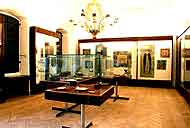The Main Steps of the Museum Activity (page 8)

In 1990s the new period in the museum history began. In 1992, the President direction referred the Sergiev Posad Museum-Reserve to the most valuable units of the national cultural heritage of the Russian Federation. According to the same direction all buildings within the fortress wall, except the Sacristy and Vicegerent Residence, completely passed to the Moscow Patriarchate. The Museum acquired buildings in the central part of the town. “The Sacristy of the Trinity-St. Sergius Lavra of the 14th – 19th c.” stayed on the Monastery territory.
 In 2001 – 2005 the museum moved to the restored parts of the new museum complex “Konny Dvor” – a monument of the 18th – 20th c. architecture. Some halls are still in the process of restoration. But the new exhibitions already demonstrate the peculiarity of the museum collection. Despite the difficulties in transportation of 100 thousand items, the collection remains integral. Under the circumstances the staff has to concentrate creative efforts which brings positive results.
In 2001 – 2005 the museum moved to the restored parts of the new museum complex “Konny Dvor” – a monument of the 18th – 20th c. architecture. Some halls are still in the process of restoration. But the new exhibitions already demonstrate the peculiarity of the museum collection. Despite the difficulties in transportation of 100 thousand items, the collection remains integral. Under the circumstances the staff has to concentrate creative efforts which brings positive results.
 Since 1990 they resumed the edition of the “Soobshcheniya”, the conferences involved more problems. Since 1998 the biannual international conferences titled “The Trinity-St. Sergius Lavra in History, Culture and Spiritual Life of Russia” with publication of the reports have been organized by the museum in co-operation with the Trinity-St. Sergius Lavra.
Since 1990 they resumed the edition of the “Soobshcheniya”, the conferences involved more problems. Since 1998 the biannual international conferences titled “The Trinity-St. Sergius Lavra in History, Culture and Spiritual Life of Russia” with publication of the reports have been organized by the museum in co-operation with the Trinity-St. Sergius Lavra.
 The new conditions inspired the development of the displaying methods. The new exhibitions “The Ancient Past of the Sergiev Posad Land” and “History of Sergiev Posad of the 20th c.” were based on the collections formed in 1980s. “The Sacristy of the Trinity-St. Sergius Lavra of the 14th – 19th cc.” reflected the attempt to show the whole complex of the collection historically formed in the Monastery.
The new conditions inspired the development of the displaying methods. The new exhibitions “The Ancient Past of the Sergiev Posad Land” and “History of Sergiev Posad of the 20th c.” were based on the collections formed in 1980s. “The Sacristy of the Trinity-St. Sergius Lavra of the 14th – 19th cc.” reflected the attempt to show the whole complex of the collection historically formed in the Monastery.
 “The Trinity-St. Sergius Lavra: Architectural ensemble and its restoration” demonstrated the development of the architectural ensemble and its restoration in connection with different events, facts and people’s life. “The Circle of Earthly Life” presents a new approach to the interpretation of folk art. The richest collection of artistic handicrafts is organized as “open depository”.
“The Trinity-St. Sergius Lavra: Architectural ensemble and its restoration” demonstrated the development of the architectural ensemble and its restoration in connection with different events, facts and people’s life. “The Circle of Earthly Life” presents a new approach to the interpretation of folk art. The richest collection of artistic handicrafts is organized as “open depository”.
|


